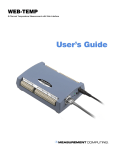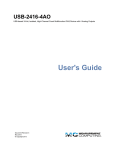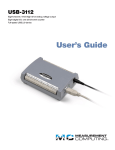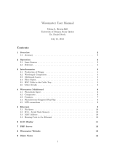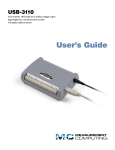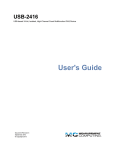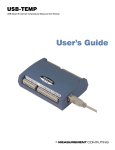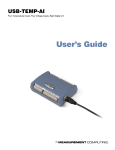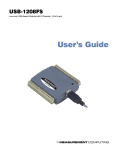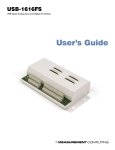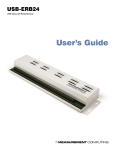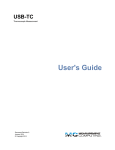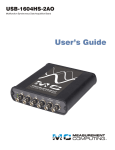Download WEB-TC User's Guide
Transcript
WEB-TC 8-Channel Thermocouple Measurement with Web Interface User's Guide Document Revision 2, December, 2007 © Copyright 2007, Measurement Computing Corporation Your new Measurement Computing product comes with a fantastic extra — Management committed to your satisfaction! Refer to www.mccdaq.com/execteam.html for the names, titles, and contact information of each key executive at Measurement Computing. Thank you for choosing a Measurement Computing product—and congratulations! You own the finest, and you can now enjoy the protection of the most comprehensive warranties and unmatched phone tech support. It’s the embodiment of our mission: To provide PC-based data acquisition hardware and software that will save time and save money. Simple installations minimize the time between setting up your system and actually making measurements. We offer quick and simple access to outstanding live FREE technical support to help integrate MCC products into a DAQ system. Limited Lifetime Warranty: Most MCC products are covered by a limited lifetime warranty against defects in materials or workmanship for the life of the product, to the original purchaser, unless otherwise noted. Any products found to be defective in material or workmanship will be repaired, replaced with same or similar device, or refunded at MCC’s discretion. For specific information, please refer to the terms and conditions of sale. Harsh Environment Warranty® Program: Any Measurement Computing product that is damaged due to misuse, or any reason, may be eligible for replacement with the same or similar device for 50% of the current list price. I/O boards face some harsh environments, some harsher than the boards are designed to withstand. Contact MCC to determine your product’s eligibility for this program 30 Day Money-Back Guarantee: Any Measurement Computing Corporation product may be returned within 30 days of purchase for a full refund of the price paid for the product being returned. If you are not satisfied, or chose the wrong product by mistake, you do not have to keep it. These warranties are in lieu of all other warranties, expressed or implied, including any implied warranty of merchantability or fitness for a particular application. The remedies provided herein are the buyer’s sole and exclusive remedies. Neither Measurement Computing Corporation, nor its employees shall be liable for any direct or indirect, special, incidental or consequential damage arising from the use of its products, even if Measurement Computing Corporation has been notified in advance of the possibility of such damages. HM WEB-TC.doc 3 Trademark and Copyright Information TracerDAQ, Universal Library, Harsh Environment Warranty, Measurement Computing Corporation, and the Measurement Computing logo are either trademarks or registered trademarks of Measurement Computing Corporation. Windows, Microsoft, and Visual Studio are either trademarks or registered trademarks of Microsoft Corporation LabVIEW is a trademark of National Instruments. CompactFlash is a registered trademark of SanDisk Corporation. XBee and XBee-PRO are trademarks of MaxStream, Inc. All other trademarks are the property of their respective owners. Information furnished by Measurement Computing Corporation is believed to be accurate and reliable. However, no responsibility is assumed by Measurement Computing Corporation neither for its use; nor for any infringements of patents or other rights of third parties, which may result from its use. No license is granted by implication or otherwise under any patent or copyrights of Measurement Computing Corporation. All rights reserved. No part of this publication may be reproduced, stored in a retrieval system, or transmitted, in any form by any means, electronic, mechanical, by photocopying, recording, or otherwise without the prior written permission of Measurement Computing Corporation. Notice Measurement Computing Corporation does not authorize any Measurement Computing Corporation product for use in life support systems and/or devices without prior written consent from Measurement Computing Corporation. Life support devices/systems are devices or systems which, a) are intended for surgical implantation into the body, or b) support or sustain life and whose failure to perform can be reasonably expected to result in injury. Measurement Computing Corporation products are not designed with the components required, and are not subject to the testing required to ensure a level of reliability suitable for the treatment and diagnosis of people. 4 Table of Contents Preface About this User’s Guide .......................................................................................................................7 What you will learn from this user’s guide......................................................................................................... 7 Conventions in this user’s guide ......................................................................................................................... 7 Where to find more information ......................................................................................................................... 7 Chapter 1 Introducing the WEB-TC.......................................................................................................................8 Web interface...................................................................................................................................................... 8 TCP/IP connection ............................................................................................................................................................ 8 Browser requirement ......................................................................................................................................................... 8 WEB-TC features ............................................................................................................................................... 8 Thermocouple input channels ........................................................................................................................................... 8 Alarms .............................................................................................................................................................................. 9 Digital I/O channels .......................................................................................................................................................... 9 WEB-TC block diagram ..................................................................................................................................... 9 Software features ................................................................................................................................................ 9 Chapter 2 Installing the WEB-TC.........................................................................................................................10 What comes with your WEB-TC shipment? .................................................................................................... 10 Hardware .........................................................................................................................................................................10 Additional documentation ................................................................................................................................................11 Unpacking the WEB-TC .................................................................................................................................. 11 Installing the software ...................................................................................................................................... 11 Connecting the AC power adapter .................................................................................................................... 11 Connecting the WEB-TC.................................................................................................................................. 11 Connecting to a LAN for communication within a network ............................................................................................12 Connecting to a LAN for communication across networks..............................................................................................12 Connecting the WEB-TC directly to a computer .............................................................................................................13 Using the web interface .................................................................................................................................... 14 Logging in to a device......................................................................................................................................................15 Configuring the WEB-TC using InstaCal ........................................................................................................ 15 Setting the network parameters ........................................................................................................................................15 Calibrating the WEB-TC .................................................................................................................................. 16 Warm-up period................................................................................................................................................ 16 Chapter 3 Signal I/O Connections .......................................................................................................................17 Screw terminal pin out ...................................................................................................................................... 17 Thermocouple input terminals (C0H/C0L to C7H/C7L) .................................................................................................18 CJC sensors ......................................................................................................................................................................18 Digital terminals (DIO0 to DIO7) ....................................................................................................................................18 Pull-up/down terminal (PU/D) .........................................................................................................................................19 Ground terminals (AGND and GND) ..............................................................................................................................19 Power terminal (+5V) ......................................................................................................................................................19 Thermocouple connections ............................................................................................................................... 19 Wiring configuration........................................................................................................................................................19 Digital I/O connections ..................................................................................................................................... 20 Configuring the DIO channels to generate alarms ...........................................................................................................20 5 WEB-TC User's Guide Chapter 4 Functional Details ...............................................................................................................................21 Thermocouple measurements ........................................................................................................................... 21 Cold junction compensation (CJC) ..................................................................................................................................21 Data linearization .............................................................................................................................................................21 Open-thermocouple detection (OTD) ..............................................................................................................................21 External components ........................................................................................................................................ 21 Screw terminals................................................................................................................................................................22 Ethernet port ....................................................................................................................................................................22 External power connector ................................................................................................................................................22 POWER/COMM LED .....................................................................................................................................................22 LINK/ACTIVITY LED ...................................................................................................................................................23 Digital logic voltage switch .............................................................................................................................................23 Factory default reset button..............................................................................................................................................23 Chapter 5 Ethernet Troubleshooting ..................................................................................................................24 Check the WEB-TC status LEDs ..................................................................................................................... 24 Check the network settings on the computer .................................................................................................... 25 Check whether DHCP is enabled on the network server..................................................................................................25 Verify that the computer is connected to the network ...................................................................................... 25 Verify the network path to the WEB-TC .......................................................................................................... 26 Verify the network path to a remote WEB-TC ................................................................................................. 27 Check cached information ................................................................................................................................ 27 Deleting a NetBIOS table entry .......................................................................................................................................27 Deleting an ARP table .....................................................................................................................................................27 Getting help ...................................................................................................................................................... 27 Chapter 6 Specifications ......................................................................................................................................28 Analog input ..................................................................................................................................................... 28 Channel configurations ..................................................................................................................................... 28 Compatible thermocouples ............................................................................................................................... 29 Accuracy ........................................................................................................................................................... 29 Thermocouple measurement accuracy .............................................................................................................................29 Throughput rate ................................................................................................................................................ 30 Digital input/output........................................................................................................................................... 31 Temperature alarms .......................................................................................................................................... 31 Memory ............................................................................................................................................................ 31 Microcontroller ................................................................................................................................................. 31 Power ................................................................................................................................................................ 32 Network ............................................................................................................................................................ 32 Ethernet compliance ........................................................................................................................................................32 Ethernet connection .........................................................................................................................................................32 Network factory default settings ......................................................................................................................................32 Network protocols............................................................................................................................................................33 Network security ..............................................................................................................................................................33 LED displays and the factory reset button ........................................................................................................ 33 Environment ..................................................................................................................................................... 33 Mechanical ....................................................................................................................................................... 33 Screw terminal connector type and pin out....................................................................................................... 34 Declaration of Conformity ..................................................................................................................35 6 Preface About this User’s Guide What you will learn from this user’s guide This user’s guide explains how to install, configure, and use the WEB-TC so that you get the most out of its web-server based thermocouple measurement features. This user’s guide also refers you to related documents available on our web site, and to technical support resources. Conventions in this user’s guide For more information on … Text presented in a box signifies additional information and helpful hints related to the subject matter you are reading. Caution! Shaded caution statements present information to help you avoid injuring yourself and others, damaging your hardware, or losing your data. < : > Angle brackets that enclose numbers separated by a colon signify a range of numbers, such as those assigned to registers, bit settings, etc. bold text Bold text is used for the names of objects on the screen, such as buttons, text boxes, and check boxes. For example: 1. Insert the disk or CD and click the OK button. italic text Italic text is used for the names of manuals and help topic titles, and to emphasize a word or phrase. For example: The InstaCal installation procedure is explained in the Quick Start Guide. Never touch the exposed pins or circuit connections on the board. Where to find more information The following electronic documents provide helpful information relevant to the operation of the WEB-TC. MCC's Specifications: WEB-TC (the PDF version of the Specifications chapter in this guide) is available on our web site at www.mccdaq.com/pdfs/WEB-TC.pdf. MCC's Quick Start Guide is available on our web site at www.mccdaq.com/PDFmanuals/DAQ-Software-Quick-Start.pdf. MCC's Guide to Signal Connections is available on our web site at www.mccdaq.com/signals/signals.pdf. MCC's Universal Library User's Guide is available on our web site at www.mccdaq.com/PDFmanuals/sm-ul-user-guide.pdf. MCC's Universal Library Function Reference is available on our web site at www.mccdaq.com/PDFmanuals/sm-ul-functions.pdf. MCC's Universal Library for LabVIEW™ User’s Guide is available on our web site at www.mccdaq.com/PDFmanuals/SM-UL-LabVIEW.pdf. WEB-TC User's Guide (this document) is also available on our web site at www.mccdaq.com/PDFmanuals/WEB-TC.pdf. For installation information, refer to the WEB-TC setup options that shipped with the device. 7 Chapter 1 Introducing the WEB-TC The WEB-TC is a thermocouple measurement device with a built-in web server. You can connect the device to an Ethernet port or hub, start up your browser, and view current data. The WEB-TC is fully supported by the Universal Library and TracerDAQ. These software programs are included on the Measurement Computing Data Acquisition Software CD. Web interface The WEB-TC's embedded web interface provides access to current data and configuration settings using a standard web browser. Browse to the device's home page by entering the URL that is printed on the device into the browser. View current thermocouple measurements and channel data, and configure hardware options from the device's home page. Only one user can change configuration options on the device at a time. The web interface is built into the device's firmware, and does not need to be installed on a computer. No external software is required other than a web browser and a TCP/IP connection. TCP/IP connection A TCP/IP connection is required to access the web interface. Connect the device's 10Base-T Ethernet port to a local or wide area network using the supplied Ethernet cable, to a single computer through a hub using the supplied Ethernet cable, or directly to a computer using a standard CAT-5 crossover cable. Browser requirement The web browser used to access the WEB-TC's web interface must support JavaScript. The web interface was tested with the following browsers for compatibility: Mozilla Firefox™ 2.x Microsoft Internet Explorer® 6.x Microsoft Internet Explorer® 7.x WEB-TC features The WEB-TC provides eight thermocouple channels and eight digital I/O channels. An external supply shipped with the device provides power. On-board LEDs display the status of communication and external power. All hardware configurable options are selectable with the web browser or InstaCal. Network configurable options are settable with InstaCal. When using InstaCal, if the login settings have been changed from the default, a login name and password are required to change the configuration settings. Thermocouple input channels The WEB-TC provides eight differential thermocouple input channels. A 24-bit analog-to-digital (A/D) converter is provided for each pair of analog inputs. You can take measurements from type J, K, R, S, T, N, E, and B thermocouples. The thermocouple type is software programmable for each channel. Four cold junction compensation (CJC) sensors are provided for thermocouple measurements. Each CJC sensor is dedicated to two thermocouple input channels. An open thermocouple detection feature lets you detect a broken thermocouple. An on-board microprocessor automatically linearizes the measurement data. 8 WEB-TC User's Guide Introducing the WEB-TC Alarms The WEB-TC features eight independent temperature alarms. Each alarm controls an associated digital I/O channel as an alarm output. The input to each alarm is one of the temperature input channels. The output of each alarm is software-configurable as active high or low. The user-configurable threshold conditions activate each alarm. When an alarm is activated, the associated DIO channel is driven to the active output state selected. Digital I/O channels Eight digital I/O channels are provided to communicate with external devices and to generate alarms. The digital bits are software programmable for input or output. The digital output voltage is switch-selectable for 3.3 V or 5 V logic. A screw terminal is provided for pull-up or pull-down configuration. The digital I/O channels power up in input mode unless the bit is configured for an alarm. When a digital bit is configured as an alarm, that bit is configured as an output and assumes the state defined by the alarm configuration. If you need to log data or display data graphically The WEB-TC displays current data read from the device, and does not log or store historical data. For logging or trending needs, use the TracerDAQ software included on the Measurement Computing Data Acquisition Software CD. WEB-TC block diagram WEB-TC functions are illustrated in the block diagram shown here. RJ-45 Ethernet Port SPI Non-isolated terminals SPI 8 DIO Controller SPI 16 Mbit Flash memory Website Storage Isolated Thermocouple terminals Ethernet MAC/PHY Controller 16-bit 40 MIPS Microchip Microcontroller Interrupt 5V DC CJC Power Sensors Input 500 V Isolation Barrier SPI UART SPI 8-bit Microchip Microcontroller Configuration EEPROM SPI Thermocouple inputs (8 channels) SPI 8 Isolated Thermocouple terminals Non-isolated terminals 5V DC External Power Figure 1. WEB-TC functional block diagram Software features For information on the features of InstaCal and the other software included with your WEB-TC, refer to the Quick Start Guide that shipped with your device. The Quick Start Guide is also available in PDF at www.mccdaq.com/PDFmanuals/DAQ-Software-Quick-Start.pdf. Check www.mccdaq.com/download.htm for the latest software version. 9 Chapter 2 Installing the WEB-TC What comes with your WEB-TC shipment? The following items are shipped with the WEB-TC. Hardware WEB-TC Ethernet cable (standard) You can optionally purchase a crossover cable (CAT-5 or higher) to connect the WEB-TC to an Ethernet card installed in a computer. External power supply and cord – 10 watt AC power adapter. MCC part number PS-5V2AEPS. 10 WEB-TC User's Guide Installing the WEB-TC Additional documentation In addition to this hardware user's guide, you should also receive the Quick Start Guide (available in PDF at www.mccdaq.com/PDFmanuals/DAQ-Software-Quick-Start.pdf). This booklet supplies a brief description of the software you received with your WEB-TC and information regarding installation of that software. Please read this booklet completely before installing any software or hardware. An overview of installation options is provided in the WEB-TC setup options page that ships with the device. Detailed installation information is provided in this user’s guide. Unpacking the WEB-TC As with any electronic device, you should take care while handling to avoid damage from static electricity. Before removing the WEB-TC from its packaging, ground yourself using a wrist strap or by simply touching the computer chassis or other grounded object to eliminate any stored static charge. If your WEB-TC is damaged, notify Measurement Computing Corporation immediately by phone, fax, or email. Phone: 508-946-5100 and follow the instructions for reaching Tech Support. Fax: 508-946-9500 to the attention of Tech Support Email: [email protected] For international customers, contact the local distributor where you purchased the WEB-TC. Click on this link www.measurementcomputing.com/sales.asp to locate your distributor. Installing the software Refer to the Quick Start Guide for instructions on installing the software on the Measurement Computing Data Acquisition Software CD. This booklet is available in PDF at www.mccdaq.com/PDFmanuals/DAQ-SoftwareQuick-Start.pdf. Connecting the AC power adapter Power to the WEB-TC is provided with the 10 watt AC power adapter (PS-5V2AEPS). Connect the adapter cord to the power connector on the WEB-TC device, and plug the AC adapter into an electrical outlet. The POWER/COMM LED illuminates when +5 V power is supplied to the WEB-TC. If the voltage supply is less than +4.75 V or more than +5.25 V, the POWER/COMM LED will not light. Refer to Figure 5 on page 22 for the location of the POWER/COMM LED. Connecting the WEB-TC A TCP/IP connection between the WEB-TC and the network or computer is required to access the device's web interface. A 10Base-T compatible Ethernet port, hub, or switch is required. You can connect the WEB-TC using the following configurations: Connect to your Local Area Network (LAN) for communication within a private network/intranet; refer to the procedure on page 12. Connect to your LAN for communication across networks (communicate over the internet, for example); refer to the procedure on page 12. Connect directly to a computer's Ethernet port for local access (requires a crossover cable (not provided) or network hub); refer to the procedure on page 13. Use the standard Ethernet cable provided to connect the WEB-TC to a TCP/IP-based local or wide area network, or to connect to a single PC through a hub or switch. Use a CAT-5 or higher crossover cable (not provided) to connect the WEB-TC to an Ethernet card installed in a computer. 11 WEB-TC User's Guide Installing the WEB-TC Once a TCP/IP connection is established, you can access the web interface from devices within the same network by entering the URL that is printed on the WEB-TC. The device's home page will open. Note: To open the home page from devices installed outside of the network, enter the public IP address set for the device. How you access the web interface once a TCP/IP connection is established depends on your configuration: When the WEB-TC is connected to the same network as the computer browser, enter the URL that is printed on the device to open the device's home page. When the WEB-TC is connected to a different network as the computer browser, enter the public IP address set for the device to open the device's home page. Refer to "Connecting to a LAN for communication across networks" below for more information. Connecting to a LAN for communication within a network Use this procedure to connect the WEB-TC to a local area network (LAN). When connected, all computers installed on the same network can access the WEB-TC's web interface. Note: This procedure assumes the network server is equipped with DHCP (dynamic host configuration protocol), and will automatically assign an IP address to the WEB-TC when it is connected to the network. 1. Connect the WEB-TC to the network using the Ethernet cable provided. The Link/Activity LED will illuminate steady green to indicate that you have established a valid Ethernet connection. 2. Open your web browser, and enter the URL that is printed on the device label. The WEB-TC Measurements page opens. You can view current measurement data from this page. A log in name (default is "webtc") and password (default is "mccdaq") are required to change configuration settings. If the WEB-TC is not recognized by the network If the WEB-TC Measurements page does not open, the server may not have DHCP, or DHCP may be disabled on the server. In either situation, assign a static IP address to the WEB-TC before connecting to the network. Refer to "Connecting the WEB-TC directly to a computer" on page 13 for instructions. After you assign the static IP address, connect to the network using the standard Ethernet cable shipped with the device, open the browser, and enter the static IP address. Configuring the WEB-TC All hardware options are configurable with InstaCal or the web interface. InstaCal must be used if any of the network parameters need to be changed, such as the IP address of your device. Configuration settings are stored in non-volatile memory in EEPROM, and are loaded on power up. Refer to the sections "Using the web interface" on page 14 and "Configuring the WEB-TC using InstaCal" on page 15 for detailed information. Connecting to a LAN for communication across networks In order to communicate with the WEB-TC from a computer connected to a different network, such as over the internet, you must change the network configuration of the network router. In the following procedure, the WEB-TC is installed at the "host" LAN, and the computer is installed at the "client" LAN. Caution! This procedure should only be performed by a network administrator or computer professional. Incorrect settings can significantly disrupt a network. 1. Connect the WEB-TC to a LAN (host) that has access to the Internet using the cable provided. The Link/Activity LED will illuminate steady green to indicate that you have established a valid Ethernet connection. 2. Configure the WEB-TC at the host LAN to access the web page: o Assign a fixed "private" static IP address to the WEB-TC. 12 WEB-TC User's Guide o o 3. Installing the WEB-TC Configure the firewall/router to map a static "public" IP address to the "private" IP address assigned above. Record this address for use in step 3. Configure the firewall/router to forward incoming traffic from the public IP address to the HTTP port ("port 80") of the private static IP address. Note: If your network has an HTTP server already running, network address translation (NAT) allows different ports to redirect to the WEB-TC on port 80. Contact your network administrator or computer professional for more information. Note: To access the device using InstaCal and the Universal Library, configure the firewall to allow incoming traffic to the UDP port ("port 54211" by default). At the client LAN, open your web browser, and enter the "public" IP address recorded in step 2 above. Note: To access the WEB-TC by name, a DNS entry must be assigned. The WEB-TC Measurements page opens. You can view current measurement data from this page. A log in name and password are required to change configuration settings. Accessing the WEB-TC using InstaCal and the Universal Library InstaCal cannot automatically detect a WEB-TC that is installed on a different subnet. To change configuration settings with InstaCal or communicate with a WEB-TC using programs written with the Universal Library, manually add the public IP address to InstaCal. InstaCal can then search the public address provided for the WEB-TC. We recommend that the port number be set to 54211 for use with InstaCal and the Universal Library. Port 80 is used for the web interface. For information on port configuration, contact your network administrator or computer professional. Configuring the WEB-TC All hardware options are configurable with InstaCal or the web interface. InstaCal must be used if any of the network parameters need to be changed, such as the IP address of your device. Configuration settings are stored in non-volatile memory in EEPROM, and are loaded on power up. Refer to the sections "Using the web interface" on page 14 and "Configuring the WEB-TC using InstaCal" on page 15 for detailed information. Connecting the WEB-TC directly to a computer Use this procedure to connect the WEB-TC directly to a computer. This scenario provides local access only, and requires that you set up your computer to use a static IP address for communication with the WEB-TC. If you are not using a network hub, a CAT-5 (or higher) crossover cable is required to connect to the computer's Ethernet port. If you are connecting to your computer through a network hub or switch, the Ethernet cable provided with your device can be used. Knowledge of network configuration is required If you are not familiar with network configurations and have questions regarding your network settings, consult your network administrator or a computer professional. 1. Select Start > Control Panel > Network Connections. 2. Double-click on Local Area Connection. 3. Select Internet Protocol (TCP/IP) and click Properties. 13 WEB-TC User's Guide 4. Installing the WEB-TC Select Use the following IP address option and enter the following: o o o IP address: Enter 192.168.0.102. Note that the last three digits of this number can be any number between 11 and 254, inclusive, but must be different from the IP address assigned to the device. The default IP address set for the WEB-TC is 192.168.0.101. Subnet mask: Enter 255.255.255.0. Default gateway: Enter 192.168.0.1. Caution! Assigning an arbitrary IP address could result in duplicate IP addresses on the network. This condition can cause a communication failure that affects both devices. Make sure when configuring static IP addresses that you set different addresses for each device. 5. Click OK. 6. Connect the WEB-TC's Ethernet port to your Ethernet hub using the supplied cable, or to your computer's Ethernet port using a CAT-5 or higher crossover cable. Note: If you connect to an Ethernet hub, you can use the Ethernet cable shipped with the device. If you have multiple WEB-TC devices, configure each device separately and assign a unique IP address to each device. You’ll need to run InstaCal to change the IP address from the default 192.168.0.101. When connected, the Link/Activity LED illuminates steady green to indicate that you have established a valid Ethernet connection, and blinks indicating network traffic. Refer to Figure 5 on page 22 for the location of the Link/Activity LED. 7. Open your browser and enter the URL address that is printed on the device label. The WEB-TC Measurements page opens. You can view current measurement data from this page. Configuring the WEB-TC All hardware options are configurable with InstaCal or the web interface. InstaCal must be used if any of the network parameters need to be changed, such as the IP address of your device. Configuration settings are stored in non-volatile memory in EEPROM, and are loaded on power up. Refer to the sections "Using the web interface" below and "Configuring the WEB-TC using InstaCal" on page 15 for detailed information. Using the web interface You can view current measurements and configure hardware options from the device's web interface. The web interface provides four tabs. Each tab represents an HTML page that is stored on the device. Measurements tab (home page) – lists the thermocouple measurements, digital values, and alarm status read from each channel on the WEB-TC. 14 WEB-TC User's Guide Installing the WEB-TC System Info tab – summarizes the current network settings set for the WEB-TC, and provides a button that when pressed flashes the POWER/COMM LED on the device. Settings on this tab are not configurable via the web interface; use InstaCal to configure network settings. Configuration tab – provides separate menu options for configuring your thermocouple, digital, and alarm options. To change configuration settings, enter the user name (default is "webtc") and password (default is "mccdaq") set for the device and click the Log In button. The user name and password cannot be changed from the web interface – you must use InstaCal to change them. o Temperature menu option – Use the options on this page to set the thermocouple type for each temperature channel pair. The factory default configuration is Disabled. The Disabled mode disconnects the analog inputs from the terminal blocks and internally grounds all of the A/D inputs. Any channel you don’t intend to use should be left disabled. o DIO menu option – Use the options on this page to set the direction of each digital I/O channel and value of each digital I/O channel configured for Output. o Alarm menu option – Use the options on this page to set up the temperature conditions to activate an alarm, and the output state of the channel (active high or low) when activated. You can configure up to eight independent alarms. The configuration options are enabled on these pages when you are logged in. The device is calibrated to the selected settings each time the "Submit" or "Calibrate" button is pressed. Help – summarizes the options on each web page, and includes step-by-step procedures for setting up your temperature channels, digital channels, and alarms. Logging in to a device Configurable options are disabled until you log in with the user name and password set for the device. Only one user can be logged in at a time. By default, the user name is set to webtc, and the password is set to mccdaq. You can change these values with InstaCal. Base64 encryption is used to encrypt the login name and password. JavaScript must be enabled on the browser to encrypt login information. If JavaScript is disabled on your browser when you log in, the user name and password values are transmitted as plain text with no encryption applied. Configuring the WEB-TC using InstaCal All hardware and network options are configurable with InstaCal. When the device is using its default configuration, InstaCal has access to all functions on the device. Login is done in the background if the default user name and password are assigned to the device. By default, the user name is set to webtc, and the password is set to mccdaq. You can change these values with InstaCal. If the user name and password have been changed, configurable options are disabled until you log in with the user name and password set for the device. Only one user can be logged in at a time. It is recommended that you change the user name and password from the default To prevent unauthorized changes to your device configuration, make sure you change the user name and password values from the default. In the event that you forget your settings, they can be reset to the default values using the reset button on the device. Pressing and holding the reset button for three seconds sets all network settings back to default including the user name and password. Note: For security purposes, do not change the log in information to the name and password used to access secure accounts, such as a credit card or bank account. Setting the network parameters Use InstaCal to change configurable network settings set on the WEB-TC. The network parameters are not accessible via the web interface. The device is shipped configured with the following default settings. 15 WEB-TC User's Guide Installing the WEB-TC Default network settings Network setting Default value Identifier DHCP setting IP address Subnet mask Gateway Server User name Password MAC address not set, optional Enabled 192.168.0.101 255.255.255.000 192.168.0.1 Enabled webtc mccdaq 00:12:71:Cx:xx:xx, where xxxxx is the device’s serial number (read-only) The following default network parameters are programmable with InstaCal. Identifier: Text that identifies the device. This value is optional, and is not set by default. Up to 48 alpha-numeric characters can be entered. DHCP: Enables configuration by a DHCP (Dynamic Host Configuration Protocol) Server. DHCP is a service that automatically assigns IP addresses to clients supporting the protocol. If the connected network has a DHCP server, the WEB-TC should be assigned an IP address shortly after it is powered up and attached to the network. InstaCal will display the IP address assigned to the WEB-TC. The default DHCP setting for the WEB-TC is Enabled. Disable this setting when the server is not DHCPenabled, or when entering a "static" IP address. Unless there is a reason to disable DHCP (such as the network server is not DHCP-enabled), we recommend that you leave DHCP enabled. IP: The Internet Protocol (IP) address that is stored on the device. Use this address when a DHCP server is not available or when DHCP is disabled. Subnet: The Subnet Mask that is stored on the device. The Subnet Mask is the part of the IP address that denotes the local Subnet. Use this address when a DHCP server is not available or when DHCP is disabled. Gateway: The Gateway IP address that is stored on the device. Use this address when a DHCP server is not available or when DHCP is disabled. A gateway is the IP address of the device that bridges subnets within a network. Server: Enables or disables the device's web page server. Enable this value to view the device's web page with a browser. Disable access to the web page when you want to restrict access to the device to InstaCal or the Universal Library API. User Name and Password: The user name and password used to log in to a device session. Log in is required only when changing configurable options on the device. Default values can be changed with InstaCal. A unique 64-bit physical (MAC) address is also assigned to the device. This address is set at the factory and is not user-configurable. Restoring factory default network settings To restore network settings to factory default values, press and hold the device's reset button for three seconds. If InstaCal is open when default settings are restored, click the Refresh Boards button on InstaCal's tool bar to reflect the changes. Calibrating the WEB-TC The WEB-TC is calibrated to the selected device settings each time a Submit or Calibrate button is pressed on a web interface configuration page, or the OK button is pressed on an InstaCal board configuration page. Warm-up period After you configure the hardware options, allow the WEB-TC to warm up for 30 minutes before taking measurements. This warm up time minimizes thermal drift and achieves the specified rated accuracy of measurements. 16 Chapter 3 Signal I/O Connections Screw terminal pin out RSVD* AGND C5L C5H RSVD* RSVD* C4L C4H NC* RSVD* NC* GND DIO7 DIO6 DIO5 DIO4 37 38 39 40 41 42 43 44 45 46 47 48 49 50 51 52 11 12 13 14 15 16 17 18 19 20 21 22 23 24 25 26 RSVD* NC* C2H C2L RSVD* RSVD* C3H C3L AGND RSVD* +5V PU/D DIO0 DIO1 DIO2 DIO3 RSVD* AGND C7L C7H RSVD* RSVD* C6L C6H NC* RSVD* 27 28 29 30 31 32 33 34 35 36 RSVD* 1 2 NC* 3 C0H 4 C0L RSVD* 5 RSVD* 6 7 C1H 8 C1L 9 AGND RSVD* 10 The WEB-TC has four rows of screw terminals — two rows on the top edge of the housing, and two rows on the bottom edge. There are 26 connections on each side. Signals are identified in Figure 2. Figure 2. WEB-TC screw terminal pin numbers *Do not make connections to the terminals labeled NC or RSVD. 17 WEB-TC User's Guide Signal I/O Connections WEB-TC screw terminal descriptions Pin 1 2 3 4 5 6 7 8 9 10 11 12 13 14 15 16 17 18 19 20 21 22 23 24 25 26 Signal Name RSVD* NC* C0H C0L RSVD* RSVD* C1H C1L AGND RSVD* RSVD* NC* C2H C2L RSVD* RSVD* C3H C3L AGND RSVD* +5V PU/D DIO0 DIO1 DIO2 DIO3 Pin Description Reserved No connect CH0 sensor input (+) CH0 sensor input (-) Reserved Reserved CH1 sensor input (+) CH1 sensor input (-) Analog ground Reserved Pin 27 28 29 30 31 32 33 34 35 36 Reserved "No Connect" CH2 sensor input (+) CH2 sensor input (-) Reserved Reserved CH3 sensor input (+) CH3 sensor input (-) Analog ground Reserved +5V output Pull-up/down for digital outputs Digital Input/Output Digital Input/Output Digital Input/Output Digital Input/Output 37 38 39 40 41 42 43 44 45 46 47 48 49 50 51 52 Signal Name RSVD* AGND C7L C7H RSVD* RSVD* C6L C6H NC* RSVD* RSVD* AGND C5L C5H RSVD* RSVD* C4L C4H NC* RSVD* NC* GND DIO7 DIO6 DIO5 DIO4 Pin Description Reserved Analog ground CH7 sensor input (-) CH7 sensor input (+) Reserved Reserved CH6 sensor input (-) CH6 sensor input (+) No connect Reserved Reserved Analog ground CH5 sensor input (-) CH5 sensor input (+) Reserved Reserved CH4 sensor input (-) CH4 sensor input (+) No connect Reserved No connect Digital ground Digital Input/Output Digital Input/Output Digital Input/Output Digital Input/Output *Make no connection to terminals labeled NC or RSVD. Use 16 AWG to 30 AWG wire for your signal connections. Tighten screw terminal connections When making connections to the screw terminals, be sure to tighten the screw until tight. Simply touching the top of the screw terminal is not sufficient to make a proper connection. Thermocouple input terminals (C0H/C0L to C7H/C7L) You can connect up to eight thermocouples to the differential sensor inputs (C0H/C0L to C7H/C7L). The WEB-TC supports type J, K, R, S, T, N, E, and B thermocouples. The thermocouple type you select will depend on your application needs. Review the temperature ranges and accuracies of each type to determine which is best suited for your application. You can connect a different thermocouple type to each channel. CJC sensors The WEB-TC has four built in high-resolution temperature sensors for thermocouple measurements. Each CJC sensor is dedicated to two thermocouple input channels, and is located behind the associated channel's screw terminal. These sensors measure the ambient temperature at the terminal block so that the cold junction voltage can be calculated. Digital terminals (DIO0 to DIO7) You can connect up to eight digital I/O lines to the screw terminals labeled DIO0 to DIO7. Each terminal is software configurable for input or output. A PU/D terminal is provided for pull-up/down configuration (explained on page 19). If a digital bit is set up as an alarm, the bit is configured for output and assumes the state defined by the alarm configuration. 18 WEB-TC User's Guide Signal I/O Connections Pull-up/down terminal (PU/D) All digital I/O lines are connected through 47k to the PU/D pin, which is floating by default. For a pull-up configuration, connect the PU/D pin to the +5V pin. For a pull-down configuration, connect the PU/D pin to the GND pin. Ground terminals (AGND and GND) The analog ground (AGND) terminals (pins 9, 19, 28, 38) provide a common ground for the thermocouple input channels. The AGND pins are isolated from the GND pin and from earth ground. Thermocouple sensors can connect to voltages that are referenced to earth ground, as long the isolation between the AGND pins and earth ground is maintained. The digital ground (GND) terminal (pin 48) provides a common ground for the digital I/O channels. The GND pin is isolated from the AGND pins and from earth ground. Power terminal (+5V) The +5V output terminal is isolated (500 VDC) from the thermocouple input channels. Caution! The +5V terminal is an output. Do not connect an external power supply to this terminal or you may damage the WEB-TC and possibly the computer. Thermocouple connections A thermocouple consists of two dissimilar metals that are joined together at one end. When the junction of the metals is heated or cooled, a voltage is produced that correlates to temperature. The WEB-TC makes fully differential thermocouple measurements without the need of ground-referencing resistors. A 32-bit floating point value in either a voltage or temperature format is returned by software. An open thermocouple detection feature is available for each analog input which automatically detects an open or broken thermocouple. Use the web interface or InstaCal to select the thermocouple type (J, K, R, S, T, N, E, and B) and one or more sensor input channel to connect the thermocouple. Wiring configuration Connect the thermocouple to the WEB-TC using a differential configuration, as shown in Figure 3. Figure 3. Typical thermocouple connection Note: There are two high/low channel pairs on each terminal. The # indicates the channel number. Do not connect any signal or sensor to the pins labeled "NC" or "RSVD". These pins must remain disconnected for the WEB-TC to operate according to specification. Thermocouples must be connected to the WEB-TC such that they are floating with respect to AGND (pins 9, 19, 28, and 38). The WEB-TC AGND pins are isolated from earth ground, so connecting thermocouple sensors to voltages referenced to earth ground is permissible as long as the isolation between the AGND pins and earth ground is maintained. 19 WEB-TC User's Guide Signal I/O Connections When thermocouples are attached to conductive surfaces, the voltage differential between multiple thermocouples must remain within ±1.4 V. For best results, we recommend the use of insulated or ungrounded thermocouples when possible. Maximum input voltage between analog input and ground The absolute maximum input voltage between an analog input and the isolated AGND pins is ±25 VDC when the WEB-TC is powered on, and ±40 VDC when the WEB-TC is powered off. If you need to increase the length of your thermocouple, use the same type of thermocouple wires to minimize the error introduced by thermal EMFs. Digital I/O connections Connect up to eight digital I/O lines to the screw terminals labeled DIO0 to DIO7. Configure each digital bit for either input or output. All digital I/O lines are connected through 47k to the PU/D pin, which is floating by default. For a pull-up configuration, connect the PU/D terminal to the +5V terminal. For a pull-down configuration, connect the PU/D terminal to the GND terminal. When configuring the digital bits for input, the digital I/O terminals can detect the state of a TTL-compatible device. The ground (GND) terminal (pin 48) provides a common ground for the digital I/O channels. Refer to the schematic shown in Figure 4. If the switch is set to the +5V input, DIO0 reads TRUE (1). If the switch is moved to GND, DIO0 reads FALSE (0). DIO0 +5V Digital GND Figure 4. Schematic showing switch detection by digital channel DIO0 When configuring the digital bits, use the switch on the side of the device to set the voltage to either 5 V or 3.3 V (see page 23 for more information). Refer to the digital I/O specification on page 31 for the maximum and minimum threshold levels for each setting. If a digital bit is set up as an alarm, that bit is configured for output and assumes the state defined by the alarm configuration. Caution! The ground pin labeled GND (pin 48) is isolated from the AGND pins and from earth ground. If a connection is made to earth ground and AGND, the thermocouples are no longer isolated. In this case, thermocouples must not be connected to any conductive surfaces that may be referenced to earth ground. For general information regarding digital signal connections and digital I/O techniques, refer to the Guide to Signal Connections (available on our web site at www.mccdaq.com/signals/signals.pdf). Configuring the DIO channels to generate alarms The WEB-TC features eight independent temperature alarms. All alarm options are configurable using the web browser or InstaCal. When a digital bit is configured as an alarm, that bit will be configured as an output on the next power cycle and assume the state defined by the alarm configuration. Each alarm controls an associated digital I/O channel as an alarm output. The input to each alarm is one of the thermocouple input channels. You set up the temperature conditions to activate an alarm, and the output state of the channel (active high or low) when activated. When an alarm is enabled, its associated I/O line is set to output and driven to the appropriate state determined by the alarm options and input temperature. Alarm configuration settings are stored in non-volatile memory and are loaded on power up. 20 Chapter 4 Functional Details Thermocouple measurements The WEB-TC hardware level-shifts the thermocouple’s output voltage into the A/D’s common mode input range by applying +2.5 V to the thermocouple’s low side at the C#L input. Always connect thermocouple sensors to the WEB-TC in a floating fashion. Do not attempt to connect the thermocouple low side C#L to GND or to a ground referencing resistor. Cold junction compensation (CJC) When connecting the thermocouple sensor leads to the sensor input channel, the dissimilar metals at the WEBTC terminal blocks produce two additional thermocouple junctions. This junction creates a small voltage error term which must be removed from the overall sensor measurement using a cold junction compensation technique. The measured voltage includes both the thermocouple voltage and the cold junction voltage. To compensate for the additional cold junction voltage, the WEB-TC subtracts the cold junction voltage from the thermocouple voltage. The WEB-TC has four high-resolution CJC temperature sensors integrated into the design. The CJC sensors are configured as one sensor for each channel pair. CJC sensors measure the average temperature at the terminal block so that the cold junction voltage can be calculated. A software algorithm automatically corrects for the additional thermocouples created at the terminal blocks by subtracting the calculated cold junction voltage from the analog input's thermocouple voltage measurement. Increasing the thermocouple length If you need to increase the length of your thermocouple, use the same type of thermocouple wires to minimize the error introduced by thermal EMFs. Data linearization After the CJC correction is performed on the measurement data, an on-board microcontroller automatically linearizes the thermocouple measurement data using National Institute of Standards and Technology (NIST) linearization coefficients for the selected thermocouple type. The measurement data is then output as a 32-bit floating point value in the configured format (voltage or temperature). Open-thermocouple detection (OTD) The WEB-TC is equipped with open-thermocouple detection for each analog input channel. OTD is automatically enabled when the channel pair is configured for thermocouple sensors. With OTD, any open-circuit or short-circuit condition at the thermocouple sensor is detected by the software. An open channel is detected by driving the input voltage to a negative value outside the range of any thermocouple output. The software recognizes this as an invalid reading and flags the appropriate channel. The firmware continues to sample all channels when OTD is detected. External components The WEB-TC has the following external components, as shown in Figure 5. Screw terminals Ethernet port External power connector Status LEDs (POWER/COMM and LINK/ACTIVITY) Digital output voltage switch Factory default reset button 21 WEB-TC User's Guide Functional Details Screw terminal Pins 27 to 52 Power connector Factory default reset button LEDs - POWER/COMM (top) and LINK/ACTIVITY (bottom) Digital output voltage switch Ethernet port Screw terminal Pins 1 to 26 Figure 5. WEB-TC component locations Screw terminals The screw terminals provide connections for sensors, digital channels, power, and ground. Detailed information is provided in Chapter 3, Signal I/O Connections, beginning on page 17. Ethernet port The WEB-TC has one 10BASE-T communication port. The port connector is an eight-position RJ-45 connector. Use the Ethernet cable provided to connect the device to a local or wide area network or to a hub attached to a single computer. Use a CAT-5 (or higher) shielded or unshielded twisted pair crossover cable to connect directly to a computer. The maximum communication distance without using a repeater is 100 meters. Data can transmit up to 100 meters at speeds of up to 100 Mbps using only one crossover Ethernet cable connected to your computer. External power connector Use the supplied external power supply (MCC p/n PS-5V2AEPS) to power the WEB-TC. POWER/COMM LED The POWER/COMM LED (upper LED) is steady green when external power is supplied. The WEB-TC has an on-board voltage supervisory circuit that monitors the 5 V external power supply. The table below explains the function of the POWER/COMM LED. LED Indication Steady green Off 4.75 V to 5.25 V external power is supplied to the WEB-TC. Check the following: External power is not supplied; verify that the supply is connected to the external power connector. A power fault has occurred. A power fault occurs when the input power falls outside of the specified voltage range of the external supply (4.75 V to 5.25 V). 22 WEB-TC User's Guide Functional Details LINK/ACTIVITY LED The LINK/ACTIVITY LED (lower LED) blinks green when a data packet is sent or received over the Ethernet connection. The table below explains the function of the LINK/ACTIVITY LED. LED Indication Blinking green Steady green Data is being transmitted or received over the Ethernet connection. The Ethernet is idle. Your network traffic has reached its maximum limit, and no communication is possible. Check with your Network Administrator. The Ethernet cable is not connected to the WEB-TC. The Ethernet cable is not connected to the network. The Ethernet cable is damaged. The Ethernet cable is not the correct type (a crossover cable is required for a direct connection.) Off Digital logic voltage switch The digital logic voltage switch lets you set the voltage to either 3.3 V or 5 V (default setting). To interface with 3.3 V logic, use the 3.3 V setting. To interface with 5 V logic, use the 5 V setting. Refer to the digital I/O specification on page 31 for the maximum and minimum threshold levels for each setting. Left = 5 V, Right = 3.3 V Figure 6. Output voltage switch positions To change the logic voltage, slide the switch left or right with a screwdriver. Factory default reset button Press and hold this button for three seconds to restore the factory default network settings on the WEB-TC. When held for 3 seconds, the POWER LED will turn off for a short time, indicating a reset is in process. When the POWER LED turns back on, reset is complete and the factory default network settings have been restored. 23 Chapter 5 Ethernet Troubleshooting There are typically only two reasons why you would be unable to communicate with the WEB-TC and access the web interface: The WEB-TC is configured incorrectly, or is operating incorrectly. The network is configured incorrectly. Though the WEB-TC is functioning normally, you are unable to communicate with it over the network. Though a detailed treatment of debugging the network is beyond the scope of this manual, there are a few things to try to determine if the problem experienced is a problem with the WEB-TC or with the network configuration. Perform the procedures below to verify the physical and network connections. Contact your network administrator for issues with your network configuration Measurement Computing provides technical support for WEB-TC connectivity and operation only. For networking issues, contact your network administrator or computer professional. Check the WEB-TC status LEDs 1. Verify the external power connection. When external power is supplied to the WEB-TC, the POWER/COMM LED illuminates steady green. o 2. If the POWER/COMM LED is off, check the power cable and the socket that the cable is plugged into. If the cable is good, plugged in, and the power to the socket is on, then the WEB-TC is not powering up correctly. Contact MCC technical support. Refer to Getting help on page 27 for contact information. Verify the Ethernet connection. The LINK/ACTIVITY LED illuminates steady green when the WEB-TC is connected to an active Ethernet hub or switch. o If the LINK/ACTIVITY LED is off, verify that the Ethernet cable is the correct type, that it is not damaged , and that it is connected correctly between the WEB-TC and a known functional server/hub/switch (or connected to your computer if you are connected directly). o If the Ethernet cable is plugged into a wall socket, check with your Network Administrator or computer professional that the wall socket is active, and that it is connected to an active Ethernet hub or switch. If you are properly connected to an active server/hub/switch and the LED is still off, there is a problem with the WEB-TC. Contact MCC technical support. Refer to Getting help on page 27 for contact information. 3. Verify the network connection: When the WEB-TC is connected to a network, the LINK/ACTIVITY LED flashes when there is activity on the network. o If the LINK/ACTIVITY LED is solid green, your network’s traffic is at its maximum limit and no communication is possible, or the network traffic is idle. Check with your network administrator. o If the LINK/ACTIVITY LED is not illuminated, there are two possibilities: You are not connected to the network, even though the WEB-TC is connected to an active server/hub/switch. An average network has at least some traffic that causes the LED to blink. Perform the procedure listed in Checking your TCP/IP settings on page 25. The WEB-TC is not receiving data, and the network connection is verified by a network administrator. Contact MCC technical support. Refer to Getting help on page 27 for contact information. 24 WEB-TC User's Guide Ethernet Troubleshooting When the WEB-TC is directly connected to a computer via a crossover cable or a single hub/switch, the LINK/ACTIVITY LED flashes when data is transmitted or received over the Ethernet connection. o If the LINK/ACTIVITY LED is not flashing, there are two possibilities: Your computer is not transmitting — verify that your TCP/IP settings are correct, and that you are using a valid IP address for both your computer and WEB-TC. Perform the procedure listed in Check the network settings on the computer TCP/IP settings below. The WEB-TC is not receiving — contact MCC technical support. Refer to Getting help on page 27 for contact information. Check the network settings on the computer If the LINK/ACTIVITY LED is not flashing, verify that your TCP/IP settings are correct, and that you are using a valid IP address for both your computer and the WEB-TC. Use the ipconfig utility to return the TCP/IP settings on your computer. 1. Open a DOS Command Prompt window from your computer. 2. Enter ipconfig and press the Return key. Your computer will display all TCP/IP network configuration values currently set on the computer. An example is shown here. o If the IP Address or Subnet Mask information are all 0’s, or if the first three sets (octets) of numbers in either the IP address or Subnet Mask do not match the device's network settings, then the computer will be unable to communicate with the WEB-TC. Contact your network administrator or computer professional. Check whether DHCP is enabled on the network server You can determine whether DHCP is enabled on the network server — open a DOS Command Prompt and enter ipconfig /all. Your computer will display additional TCP/IP information, including the status of DHCP on the network server. Contact your network administrator regarding network settings Changes to network configuration should only be performed by your network administrator or computer professional. Verify that the computer is connected to the network You can ping (Packet InterNet Groper) the computer to verify that it is connecting to your network. Ping is a diagnostic utility used to send a request to a device. The device then returns a response. Enter ping followed by the IP address of the computer. Using the address returned in the example above with ipconfig, enter ping 127.0.0.01 and press the Return key. This address tells the computer to test its network setup. 25 WEB-TC User's Guide Ethernet Troubleshooting If your computer is connected to the network, a message similar to the one shown here is returned. If your computer is not connected to the network, a "Request timed out" error or a "Destination host unreachable" message is returned. Check with your network administrator. Verify the network path to the WEB-TC You can ping the WEB-TC to verify that the network path from the computer to the device is set up correctly. Enter ping followed by the IP address of the WEB-TC. For example, enter ping 192.168.0.10 and press the Return key. If you can successfully communicate with the WEB-TC, a message similar to the one below is returned. If a "Request timed out" error or a "Destination host unreachable" message is returned, the network settings may not be set correctly. Press the RESET button on the WEB-TC to reset the network configuration settings to factory default values. If DHCP is enabled, an IP address is automatically assigned to the device. If DHCP is not enabled, assign the device a unique static IP address and re-establish communication with the WEB-TC. Refer to Connecting the WEB-TC directly to a computer on page 13 for information on how to assign a static IP address. If the RESET button does not restore the network settings, the microcontroller on the WEB-TC may not be working. Contact MCC technical support. Refer to Getting help on page 27 for contact information. Contact your network administrator regarding network settings Changes to network configuration should only be performed by your network administrator or computer professional. 26 WEB-TC User's Guide Ethernet Troubleshooting Verify the network path to a remote WEB-TC You can ping the network where the WEB-TC is installed to verify that the network path from the computer to a device installed on a different network is set up correctly. Enter ping followed by the public IP address of the network where the WEB-TC is installed. If a "Request timed out" error or a "Destination host unreachable" message is returned, verify that you have the correct public address for the network where the WEB-TC is installed. If you get a response from the ping of the public network but still cannot communicate with the WEB-TC, check the following: A unique, fixed "static" IP address has been assigned to the WEB-TC. The firewall is configured to allow incoming traffic to the HTTP port ("port 80") for access to the web page. The firewall is configured to allow incoming traffic to the UDP port ("port 54211" by default) for access through InstaCal and the Universal Library. The network at the public IP address is configured to access the fixed address assigned to the WEB-TC. Contact your network administrator regarding firewall settings Changes to network configuration should only be performed by your network administrator or computer professional. Check cached information When your network configuration changes - for example, when you change the static address on one of your devices - you may have obsolete information on PCs that have previously accessed your device. You may be able to update this information simply by disconnecting the network cable from the PC on which the problem exists and reconnecting it. After a short time, the cached information should update. If this doesn’t work, the following procedures may help. Deleting a NetBIOS table entry If NetBIOS is enabled, ―nbtstat -c‖ will provide a list of names and IP addresses. If the webtc name is listed, check the associated IP address. If it is different, try typing ―nbtstat -R‖ to purge the NetBIOS cache. Deleting an ARP table If you suspect that two devices on a network are assigned the same IP address, you can delete the ARP table (Address Resolution Protocol). Do the following: 1. Open a Command Prompt (DOS) window. 2. Enter arp –d followed by the address found in step 2 (192.168.0.102 for example) and press Enter. The ARP table will update with the current IP addresses assigned to devices on the network. Getting help If you are unable to communicate with the WEB-TC, first contact your network administrator or computer professional to verify that you are using the correct TCP/IP network settings, and that your network configuration is working. If the network configuration and settings are properly set but you still cannot communicate with the WEB-TC, the problem may be with the WEB-TC. For hardware related issues, contact Measurement Computing Corporation technical support by phone, fax, or email. Phone: 508-946-5100 and follow the instructions for reaching Tech Support. Fax: 508-946-9500 to the attention of Tech Support Email: [email protected] For international customers, contact the local distributor where you purchased the WEB-TC. Click on this link www.measurementcomputing.com/sales.asp to locate your distributor. 27 Chapter 6 Specifications Typical for 25 °C unless otherwise specified. Specifications in italic text are guaranteed by design. Analog input Table 1. Generic analog input specifications Parameter Conditions Specification Thermocouple Four dual 24-bit, Sigma-Delta type 8 differential 500 VDC minimum between field wiring and power supply input. Software programmable to match sensor type ±0.080 V A/D converters Number of channels Input isolation Channel configuration Differential input voltage range Absolute maximum input voltage ±C0x through ±C7x relative to AGND (pins 9, 19, 28, 38) Input impedance Input leakage current Common mode rejection ratio ADC Resolution ADC No missing codes Input coupling Warm-up time Open thermocouple detect CJC sensor accuracy Open thermocouple detect disabled Open thermocouple detect enabled fIN = 60 Hz 15 °C to 35 °C 0 °C to 55 °C ±25 V (power on) ±40 V (power off) 5 Gigohm (power on) 1 Mohm (power off) 30 nA max. 105 nA max. 100 dB min. 24 bits 24 bits DC 30 minutes min. The maximum open detection time is 3 seconds. -0.75 °C to 0.5 °C max. -1.5 °C to 1.25 °C max. Channel configurations Table 2. Channel configuration specifications Sensor Category Conditions Specification Thermocouple J, K, S, R, B, E, T, or N 8 differential channels Note 1: Channel configuration information is stored on a EEPROM external to the isolated microcontroller by the firmware whenever any item is modified. Modification is performed by commands issued over Ethernet from an external application, and the configuration is made non-volatile through the use of the EEPROM. Note 2: The factory default configuration is Type J. 28 WEB-TC User's Guide Specifications Compatible thermocouples Table 3. Compatible sensor type specifications Parameter Conditions Thermocouple J: -210 °C to 1200 °C K: -270 °C to 1372 °C R: -50 °C to 1768 °C S: -50 °C to 1768 °C T: -270 °C to 400 °C N: -270 °C to 1300 °C E: -270 °C to 1000 °C B: 0 °C to 1820 °C Accuracy Thermocouple measurement accuracy Table 4. Thermocouple accuracy specifications, including CJC measurement error. All specifications are (±). Sensor Type Sensor temperature Accuracy error maximum (°C) Accuracy error typical (°C) Tempco (°C/°C) J -210 °C 0 °C 1200 °C -210 °C 0 °C 1372 °C -50 °C 250 °C 1768 °C -50 °C 250 °C 1768 °C 250 °C 700 °C 1820 °C -200 °C 0 °C 1000 °C -200 °C 0 °C 400 °C -200 °C 0 °C 1300 °C 3.098 1.282 1.178 3.318 1.292 1.495 1.892 0.853 0.734 2.010 0.844 0.612 2.199 0.824 0.471 3.050 1.465 1.010 3.226 1.334 0.856 3.406 1.300 0.978 1.762 0.724 0.684 1.843 0.730 0.799 1.058 0.479 0.416 1.124 0.475 0.347 2.192 0.821 0.469 1.708 0.826 0.564 1.797 0.754 0.496 1.897 0.735 0.571 0.040 K S R B E T N 29 0.045 0.027 0.025 0.004 0.038 0.045 0.035 WEB-TC User's Guide Specifications Note 3: Thermocouple measurement accuracy specifications include polynomial linearization, cold-junction compensation and system noise. These specs are for one year, or 3000 operating hours, whichever comes first, and for operation of the WEB-TC between 15 °C and 35 °C after 30 minute warm-up. The tempco should be applied to the accuracy specifications for operation at an ambient temperature outside of the 15 °C and 35 °C range. There are total of four CJC sensors, two per side of the module. Each CJC sensor is dedicated to one of the four channel pairs. The accuracy listed above assumes the screw terminals are at the same temperature as the CJC sensor. Errors shown do not include inherent thermocouple error. Contact your thermocouple supplier for details on the actual thermocouple accuracy error. Note 4: Thermocouples must be connected to the WEB-TC such that they are floating with respect to AGND (pins 9, 19, 28, 38, 48). The WEB-TC AGND pins are isolated from earth ground. You can connect thermocouple sensors to voltages referenced to earth ground as long as the isolation between the AGND pins and earth ground is maintained. Note 5: When thermocouples are attached to conductive surfaces, the voltage differential between multiple thermocouples must remain within ±1.4 V. For best results, we recommend using insulated or ungrounded thermocouples when possible. Throughput rate Table 5. Throughput rate specifications Number of Input Channels Maximum Throughput 1 2 3 4 5 6 7 8 2 Samples/second 2 S/s on each channel, 4 S/s total 2 S/s on each channel, 6 S/s total 2 S/s on each channel, 8 S/s total 2 S/s on each channel, 10 S/s total 2 S/s on each channel, 12 S/s total 2 S/s on each channel, 14 S/s total 2 S/s on each channel, 16 S/s total Note 6: The analog inputs are configured to run continuously. Each channel is sampled twice per second. The maximum latency between when a sample is acquired and the temperature data is provided by the Ethernet unit is approximately 0.5 seconds. 30 WEB-TC User's Guide Specifications Digital input/output Table 6. Digital input/output specifications Digital type Number of I/O Configuration CMOS 8 (DIO0 through DIO7) Independently configured for input or output. Switch selectable output voltages: +5 V and +3.3 V Power on reset is Input mode except when bits are configured to operate as alarms. Power on conditions Pull-up/pull-down configuration Digital I/O transfer rate (software paced) Input high voltage (+5 V mode) Input high voltage (+3.3 V mode) Input low voltage (+5 V mode) Input low voltage (+3.3 V mode) Output low voltage (IOL = 2.5 mA) Output high voltage (IOH=-2.5 mA) All pins are connected to 47 kOhm resistors that share a common point accessible at Pin 22 of the device (PU/D). This pin is floating by default and is user-configurable via external connection. For pull-up mode, connect this pin to Pin 21 (+5V). For pull-down mode, connect this pin to Pin 48 (GND). Digital input – 50 port reads or single bit reads per second typical. Digital output – 100 port writes or single bit writes per second typical. 4 V min, 5.5 V absolute max. 2.64 V min, 5.5 V absolute max. 1 V max., -0.3 V absolute min. 0.66 V max., -0.3 V absolute min. 0.6 V max. 4.3 V min. (+5 V mode), 2.7 V (+3.3 V mode) Note 7: Ground pins on the WEB-TC labeled GND are isolated from AGND pins and from earth ground. Temperature alarms Table 7. Temperature alarm specifications Number of alarms Alarm functionality Alarm input modes Alarm output modes Alarm update rate 8 (one per digital I/O line) Each alarm controls its associated digital I/O line as an alarm output. The input to each alarm may be any of the analog temperature input channels. When an alarm is enabled, its associated I/O line is set to output and driven to the appropriate state determined by the alarm options and input temperature. The alarm configurations are stored in non-volatile memory and are loaded at power on. Alarm when input temperature > T1 Alarm when input temperature > T1, reset alarm when input temperature goes below T2 Alarm when input temperature < T1 Alarm when input temperature < T1, reset alarm when input temperature goes above T2 Alarm when input temperature is < T1 or > T2 Note: T1 and T2 may be independently set for each alarm. Disabled, digital I/O line may be used for normal operation Enabled, active high output (digital I/O line goes high when alarm condition is met) Enabled, active low output (digital I/O line goes low when alarm condition is met) 1 second Memory Table 8. Memory specifications EEPROM FLASH 512 bytes for sensor configuration 2 MB for device configuration and website storage Microcontroller Table 9. Microcontroller specifications Type One high-performance 8-bit RISC microcontroller (isolated) One high-performance 16-bit RISC microcontroller (non-isolated) 31 WEB-TC User's Guide Specifications Power Table 10. Power specifications Parameter Conditions Specification Supply current (Note 9) External power input (Note 8) Continuous mode External power supply (included) Voltage supervisor limits MCC p/n PS-5V2AEPS 4.75 V > Vext or Vext > 5.25 V 4.75 V < Vext < 5.25 V Available at +5V screw terminal Available at +5V screw terminal 440 mA max. +5 VDC ± 5% (+5 VDC power supply provided) +5 VDC, 10W, 5% regulation PWR LED = Off; (power fault) PWR LED = On 4.65 V min., 5.25 V max. 10 mA max User output voltage range User output current available Note 8: Voltage specification applies at barrel plug power input. The power supply provided with the board meets this specification at the rated total power supply current. If a different power supply is used, small line resistances could cause significant voltage drop between the power supply and the barrel plug input. Note 9: This is the total current requirement for the WEB-TC which includes up to 20 mA for the LEDs and 10 mA for the user voltage output. Network Ethernet compliance Table 11. Ethernet compliance specifications Device type Device compatibility IEEE 802.3 Ethernet 10Base-T IEEE 802.3-2003 10 Mpbs Media Access Control Ethernet connection Table 12. Ethernet connection specifications Ethernet type Connector Cable Length MAC address 10Base-T RJ-45, 8 position CAT-5 shielded, unshielded twisted pair 100 meters max. 00:12:71:Cx:xx:xx, where xxxxx is the device’s serial number Network factory default settings Table 13. Factory default specifications Factory default IP address Factory default subnet mask Factory default Gateway Factory default DHCP setting Factory default user name Factory default password Web Server 192.168.0.101 255.255.255.0 192.168.0.1 Enabled "webtc" "mccdaq" Enabled 32 WEB-TC User's Guide Specifications Network protocols Table 14. Factory default specifications Protocols implemented UDP messaging protocol TCP downloading protocol HTTP 1.0 alternate port Network name Network name publication Max number of simultaneous HTTP connections Max number of non-HTTP TCP sockets IP, ARP, ICMP, DHCP, UDP, TCP, NBNS, HTTP Protocols using UDP or TCP for transport communicate on their IETF assigned ports (for example HTTP on TCP port 80). UDP port 54211 TCP port 54267 TCP port 49152-65535 (not including 54267) "webtc_xxxxx", where xxxxx is the device's serial number via NBNS (responds to b-node broadcasts, therefore only available on the local subnet) 3 5 Network security Table 15. Factory default specifications Security implementation Session timeout User-name/password encryption Vulnerabilities IP address based session manager with user-name/password login for configuration and control transactions (data is not secured.) 5 minutes with no activity Base64 (The default web page does not support encryption if Javascript is disabled in the web browser.) Denial of service attacks, user-name/password spoofing, script probing and simple decryption LED displays and the factory reset button Table 16. LED and button configurations POWER/COMM LED (top) LINK/ACTTIVITY LED (bottom) Factory reset button 4.75 V < Vext < 5.25 V On Vext < 4.75 V, Vext > 5.25 V Off (power fault) Blinks during microcontroller communications. On when there is a valid Ethernet connection and blinks when an Ethernet packet is sent or received. When held for 3 seconds, the POWER LED will turn off for a short time, indicating a reset is in process. When the POWER LED turns back on, reset is complete and the factory default network settings have been restored. Environment Table 17. Environmental specifications Operating temperature range Storage temperature range Humidity 0 to 55 ° C -40 to 85 ° C 0 to 90% non-condensing Mechanical Table 18. Mechanical specifications Dimensions 127 mm (L) x 88.9 mm (W) x 35.56 (H) 33 WEB-TC User's Guide Specifications Screw terminal connector type and pin out Table 19. Screw terminal connector specifications Connector type Wire gauge range Screw terminal 16 AWG to 30 AWG Table 20. Screw terminal pin out Pin 1 2 3 4 5 6 7 8 9 10 11 12 13 14 15 16 17 18 19 20 21 22 23 24 25 26 Signal Name RSVD NC C0H C0L RSVD RSVD C1H C1L AGND RSVD RSVD NC C2H C2L RSVD RSVD C3H C3L AGND RSVD +5V PU/D DIO0 DIO1 DIO2 DIO3 Note 10: Pin Description Reserved - see Note 10 No connect - see Note 10 CH0 sensor input (+) CH0 sensor input (-) Reserved - see Note 10 Reserved - see Note 10 CH1 sensor input (+) CH1 sensor input (-) Analog ground Reserved - see Note 10 Pin 27 28 29 30 31 32 33 34 35 36 Reserved - see Note 10 No connect - see Note 10 CH2 sensor input (+) CH2 sensor input (-) Reserved - see Note 10 Reserved - see Note 10 CH3 sensor input (+) CH3 sensor input (-) Analog ground Reserved - see Note 10 +5V output Pull-up/down for digital outputs Digital Input/Output Digital Input/Output Digital Input/Output Digital Input/Output 37 38 39 40 41 42 43 44 45 46 47 48 49 50 51 52 Signal Name RSVD AGND C7L C7H RSVD RSVD C6L C6H NC RSVD RSVD AGND C5L C5H RSVD RSVD C4L C4H NC RSVD NC GND DIO7 DIO6 DIO5 DIO4 Do not make connections to pins marked "NC" or "RSVD". 34 Pin Description Reserved - see Note 10 Analog ground CH7 sensor input (-) CH7 sensor input (+) Reserved - see Note 10 Reserved - see Note 10 CH6 sensor input (-) CH6 sensor input (+) No connect - see Note 10 Reserved - see Note 10 Reserved - see Note 10 Analog ground CH5 sensor input (-) CH5 sensor input (+) Reserved - see Note 10 Reserved - see Note 10 CH4 sensor input (-) CH4 sensor input (+) No connect - see Note 10 Reserved - see Note 10 No connect - see Note 10 Digital ground Digital Input/Output Digital Input/Output Digital Input/Output Digital Input/Output Declaration of Conformity Manufacturer: Address: Category: Measurement Computing Corporation 10 Commerce Way Suite 1008 Norton, MA 02766 USA Electrical equipment for measurement, control and laboratory use. Measurement Computing Corporation declares under sole responsibility that the product WEB-TC EU EMC Directive 89/336/EEC: Electromagnetic Compatibility, EN 61326 (1997) Amendment 1 (1998) Emissions: Group 1, Class A EN 55011 (1990)/CISPR 11: Radiated and Conducted emissions. Immunity: EN61326, Annex A IEC 61000-4-2 (1995): Electrostatic Discharge immunity, Criteria B. IEC 61000-4-3 (1995): Radiated Electromagnetic Field immunity Criteria B. IEC 61000-4-4 (1995): Electric fast transient burst immunity Criteria B. IEC 61000-4-5 (1995): Surge immunity Criteria A. IEC 61000-4-6 (1996): Radio frequency common mode immunity Criteria B. IEC 61000-4-8 (1994): Power frequency magnetic field immunity Criteria A. IEC 61000-4-11 (1994): Interrupt immunity Criteria A. Declaration of Conformity based on tests conducted by Chomerics Test Services, Woburn, MA 01801, USA in August, 2007. Test records are outlined in Chomerics Test Report #EMI4891A.07. We hereby declare that the equipment specified conforms to the above Directives and Standards. Carl Haapaoja, Director of Quality Assurance Measurement Computing Corporation 10 Commerce Way Suite 1008 Norton, Massachusetts 02766 (508) 946-5100 Fax: (508) 946-9500 E-mail: [email protected] www.mccdaq.com




































